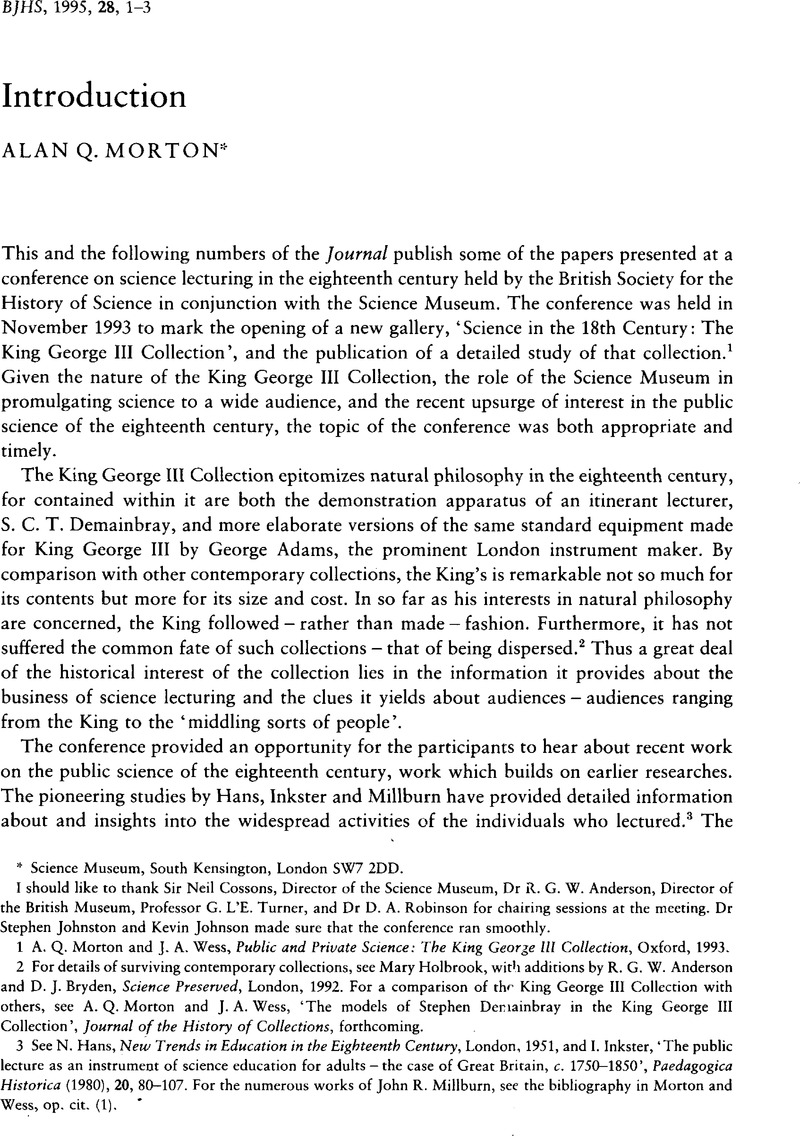Article contents
Introduction
Published online by Cambridge University Press: 05 January 2009
Abstract

Information
- Type
- Introduction
- Information
- Copyright
- Copyright © British Society for the History of Science 1995
References
1 Morton, A. Q. and Wess, J. A., Public and Private Science: The King George III Collection, Oxford, 1993.Google Scholar
2 For details of surviving contemporary collections, see Holbrook, Mary, with additions by Anderson, R. G. W. and Bryden, D. J., Science Preserved, London, 1992Google Scholar. For a comparison of thr King George III Collection with others, see Morton, A. Q. and Wess, J. A., ‘The models of Stephen Demainbray in the King George III Collection’, Journal of the History of Collections, forthcoming.Google Scholar
3 See Hans, N., New Trends in Education in the Eighteenth Century, London, 1951Google Scholar, and Inkster, I., ‘The public lecture as an instrument of science education for adults – the case of Great Britain, c. 1750–1850’, Paedagogica Historica (1980), 20, 80–107CrossRefGoogle Scholar. For the numerous works of John R. Millburn, see the bibliography in Morton, and Wess, , op. cit. (1).Google Scholar
4 See Heilbron, John L., Physics at the Royal Society during Newton's Presidency, Los Angeles, 1983Google Scholar; Hunter, Michael, Establishing the New Science: The Experience of the Early Royal Society, Woodbridge, 1989Google Scholar. For the later period see Inkster, Ian and Morrell, Jack (eds.), Metropolis and Province. Science in British Culture 1780–1850, London, 1983Google Scholar; Inkster, Ian, ‘The social context of an educational movement: a revisionist approach to the English mechanics' institutes, 1820–50’, Oxford Review of Education (1976), 2, 277–307.CrossRefGoogle Scholar
5 See Schaffer, Simon, ‘Natural philosophy and public spectacle in the eighteenth century’, History of Science (1983), 21, 1–43CrossRefGoogle ScholarPubMed and his ‘Machine philosophy: demonstration devices in Georgian mechanics’, Osiris (1994), 9, 157–82.Google Scholar
6 Golinski, J. C., Science as Public Culture: Chemistry and Enlightenment in Britain, 1760–1820, Cambridge, 1992Google Scholar; Stewart, Larry, The Rise of Public Science: Rhetoric, Technology and Natural Philosophy in Newtonian Britain, 1660–1750, Cambridge, 1992.Google Scholar
7 Musson, A. E. and Robinson, E., Science and Technology in the Industrial Revolution, Manchester, 1969Google Scholar; Cardwell, D. S. L., Technology, Science and History, London, 1972Google Scholar; Jacob, M. C., The Cultural Meaning of the Scientific Revolution, New York, 1988Google Scholar; Inkster, Ian, Science and Technology in History: An Approach to Industrial Development, London, 1991.CrossRefGoogle Scholar
8 See Brewer, John and Porter, Roy (eds.), Consumption and the World of Goods, London, 1993.Google Scholar
- 1
- Cited by

